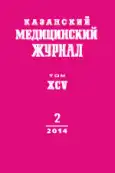Risk factors and clinical features of recurrent stroke in the Tyva Republic
- Authors: Mongush K.D1, Ondar AB1, Chylbak-ool RC.1, Balchir MB1, Mongush C.O1
-
Affiliations:
- Scientific and Research Institution of Medical and Social Problems and Management of Ministry of Health and Social Development of Republic of Tyva, Kyzyl, Russia
- Issue: Vol 95, No 2 (2014)
- Pages: 199-202
- Section: Theoretical and clinical medicine
- URL: https://journals.rcsi.science/kazanmedj/article/view/2063
- DOI: https://doi.org/10.17816/KMJ2063
- ID: 2063
Cite item
Full Text
Abstract
Keywords
Full Text
##article.viewOnOriginalSite##About the authors
Kh D Mongush
Scientific and Research Institution of Medical and Social Problems and Management of Ministry of Health and Social Development of Republic of Tyva, Kyzyl, Russia
Email: kherelmaa69-5@mail.ru
A B Ondar
Scientific and Research Institution of Medical and Social Problems and Management of Ministry of Health and Social Development of Republic of Tyva, Kyzyl, Russia
R Ch Chylbak-ool
Scientific and Research Institution of Medical and Social Problems and Management of Ministry of Health and Social Development of Republic of Tyva, Kyzyl, Russia
M B Balchir
Scientific and Research Institution of Medical and Social Problems and Management of Ministry of Health and Social Development of Republic of Tyva, Kyzyl, Russia
Ch O Mongush
Scientific and Research Institution of Medical and Social Problems and Management of Ministry of Health and Social Development of Republic of Tyva, Kyzyl, Russia
References
- Быков Ю.Н., Файзулин Е.Р. Реабилитация больных с последствиями церебрального ишемического инсульта в условиях поликлиники // Сибир. мед. ж. - 2009. - №5. - С. 20-23.
- Верещагин Н.В., Гулевская Т.С., Миловидов Ю.К. Актуальные проблемы кардионеврологии // Клин. мед. - 1991. - №3. - С. 3-6.
- Гусев Е.И., Виленский Б.С., Скоромец А.А. и др. Основные факторы, влияющие на исход инсультов // Ж. невропатол. и психиатр. - 1995. - Т. 95, вып. 1. - С. 4-7.
- Инсульт: диагностика, лечение, профилактика / Под ред. З.А. Суслиной, М.А. Пирадова. - М.: МЕДпресс-информ, 2008. - 288 с.
- Скворцова В.И., Евзельман М.А. Ишемический инсульт. - Орёл, 2006. - 404 с.
- Смирнов В.Е. Эпидемиология мозгового инсульта // Ж. невропатол. и психиатр. - 1991. - №11. - С. 111-116.
Supplementary files






